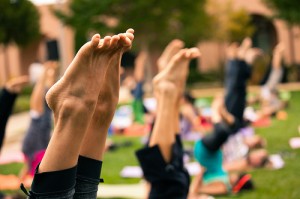How To Make Your Workout Happily Mindful
 *Photo Credit: Lululemon Athletica via Compfight
*Photo Credit: Lululemon Athletica via Compfight
Mindful exercise is an amazing way to unwind, clear your head, and have a great experience while at the gym or working out. But it can take practice. Personally, I often have lofty goals for the "mindfulness" of my evening walks, but then find my mind shooting off to the grocery list or an upcoming meeting by the very first step. Don’t be discouraged if this happens to you too. Remember, as you lace up your shoes, that minds are prone to wander. As best you can with mindful exercise, allow yourself to enter a judgment-free zone before you workout. Reinforce to yourself that the truly important point of mindful exercise is full awareness of each and every moment, not performance. By doing that you will find yourself having a much richer and engaging experience than you would otherwise.
As you develop and grow your mindful exercise routine, you may find it helpful to start by bringing awareness to some of the following:
Breath
As you start your workout, try to focus on the sound of your breath or the rise and fall of your chest as you breathe. You might also want to experiment with breathing in through the nose and out through the mouth, making a soft whooshing sound as we did in some of our earlier exercises. This will help you focus and increase circulation as you get your muscles moving.
Footfall
As you start getting further into your workout, another great focal point is the feeling and sound of each footfall. Pay particular attention to the feeling of each foot as it rolls across the ground. If you are biking, focus on the pressure of your feet against the pedals.
Muscle Tension
Once things start really heating up, take your attention to your different muscle groups. Just like the body scan, begin with your feet then move up to your legs, abdomen, back, etc. If there is an area with significant discomfort, you might want to explore this sensation fully before returning to your previous area of focus.
Sound
If you start getting tired, or find your mind just can’t stay focused, turn your attention to sound. Observe what different types of sounds are around you, their pitches and volumes, even their duration. Try not to get lost in thoughts about the sound, but simply listen as if hearing for the first time.
The Ball
If you are playing a sport with a ball like tennis or golf, you might make the ball your focal point. As best you can, try to really “see” the ball. If you find your mind drifting off or you begin judging your performance, simply note where your mind has gone and return your attention once again to the ball.
Try Yoga or Tai Chi
If you’re anything like me, an on the go, high energy sort of person, it might help to supplement your more intense workouts with a slower practice such as yoga or tai chi. Research has shown that mindful low-exertion activities have a substantial benefit on mood. These actives are not only associated with improvements in wellbeing and self-esteem, but also help to decrease stress, anxiety and depression. Check it out in either this article or this one by the National Institute of Health:
Whatever exercise you chose, don't forget to try out the above tips! Mindful exercise should ultimately lead to better health, greater insight and, most importantly to the Aikens Approach, an improved sense of wellbeing and quality of life!
← Thought is Not Reality From the Doctor: The Health Facts of Yoga →